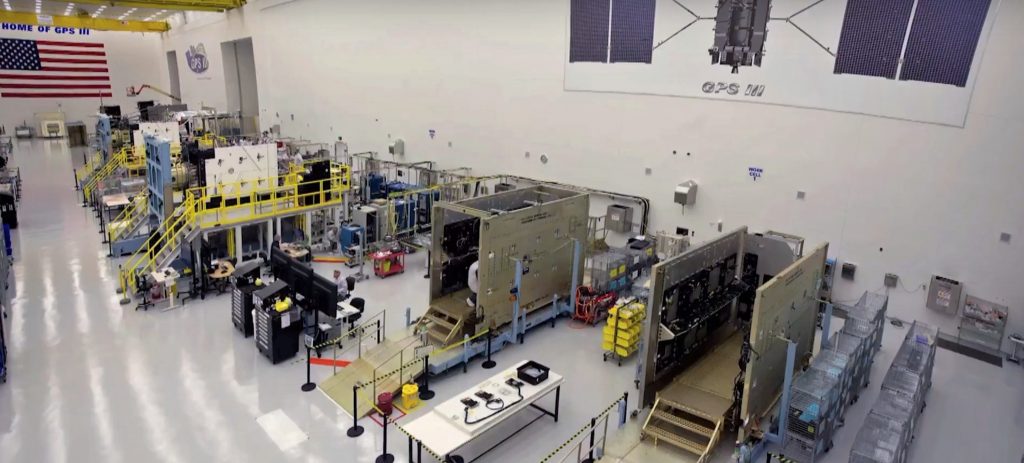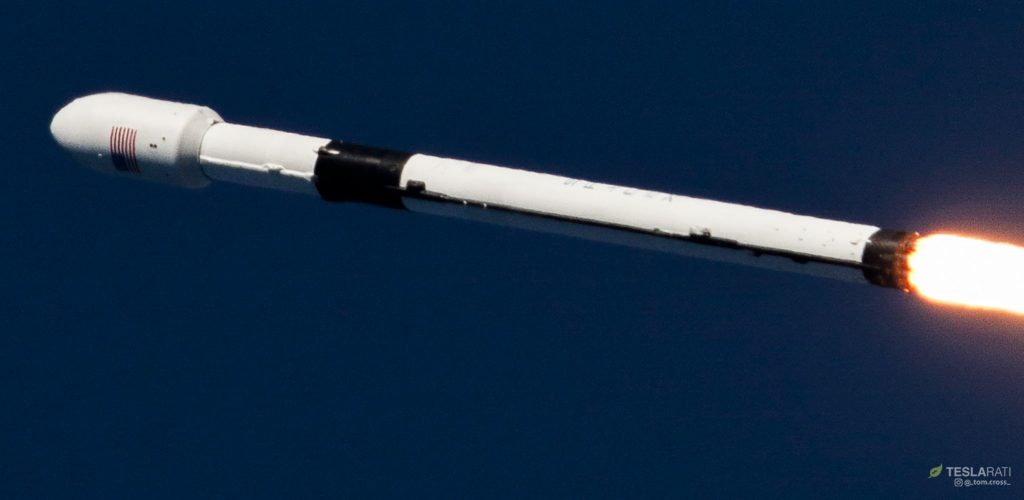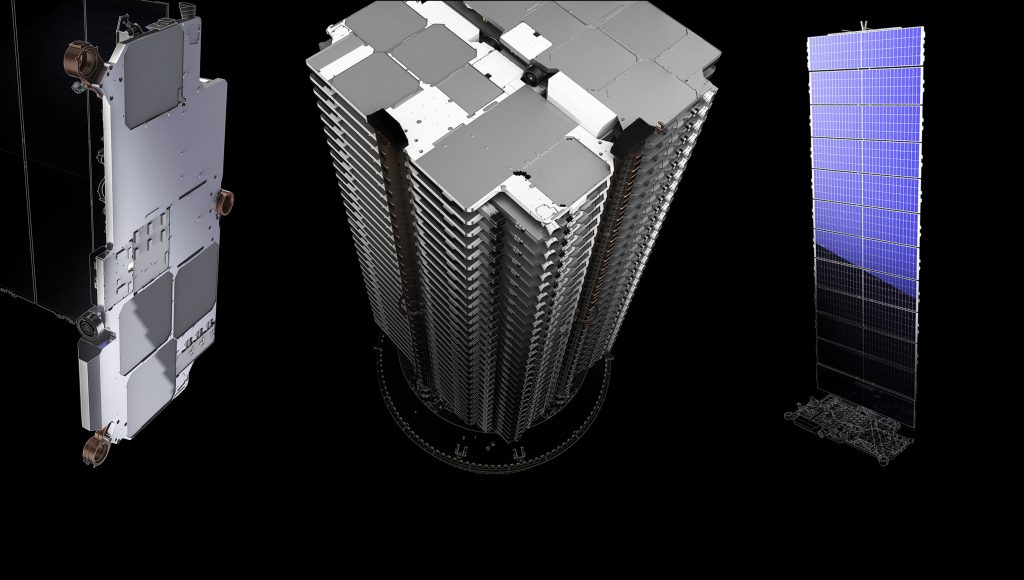

News
SpaceX Falcon 9’s next major US Air Force launch slips into early 2020 ahead of busy Q4
According to an August 20th update from the US Air Force’s Space and Missile Systems Center (SMC), SpaceX’s next dedicated USAF launch – the third completed GPS III spacecraft – has slipped one month and is now scheduled no earlier than (NET) January 2020.
Known as GPS III Space Vehicle 03 (SV03), SpaceX’s next US military launch will follow just a few months after United Launch Alliance (ULA) is set to launch GPS III SV02, scheduled to lift off at 9am EDT, August 22nd. SpaceX kicked off the lengthy GPS III launch campaign in December 2018, successfully placing the ~3900 kg (8600 lb) communications and geolocation spacecraft into a transfer orbit. The mission also marked SpaceX’s first intentionally expendable Falcon 9 Block 5 launch, a trend that may or may not continue with the company’s next GPS launch.
Known as GPS Block IIIA, SV01-03 are the first three of a batch of 10 spacecraft total, produced by Lockheed Martin for an anticipated cost of roughly $600M apiece. The US Government Accountability Office (GAO) expects [PDF] little to no cost savings per unit for Block IIIA’s follow-up, Block IIIF, in which 22 additional GPS III spacecraft will be built to fully upgrade the military’s GPS constellation. GAO estimates that those 22 satellites – likely to also be built by Lockheed Martin – will cost an incredible $12B, or ~$550M apiece.
On the scale of the US military’s woefully inefficient space procurement apparatus, ~$600M per satellite is sadly a pretty good deal. Two equally modern USAF satellite acquisition programs – the Advanced Extremely High Frequency (AEHF) and Space-Based Infrared System constellations – have both surpassed their initial cost estimates by more than a factor of two. Over the entire program, GAO estimates that six AEHF satellites no less than $3 billion each, while SBIRS is in even worse shape with six new satellites expected to cost $3.2 billion apiece.

Meanwhile, the Raytheon-built ‘OCX’ ground systems needed to take advantage of the ~$19B GPS III satellite upgrades has been just as much of an acquisition boondoggle, nearly doubling in cost over the last few years, bringing its final cost to no less than $6.2B after years of delays. All told, completing the upgraded GPS III constellation can be expected to cost a bare minimum of $25B. This cost doesn’t even include launches, but the cost of launching all the spacecraft is – in a rare instance – going to be a small fraction of the overall acquisition, perhaps $3-4B for all 32 satellites.
Regardless of the nightmarish costs and general inefficiency, Lockheed Martin and the USAF continue to slowly march towards initial GPS III operability. August 22nd’s ULA launch and January 2020’s SpaceX launch will take significant steps towards that capability, and will – with any luck – be followed by an additional two Falcon 9 GPS III launches in 2020. Six of ten IIIA satellites have already had launch contracts awarded, five of six of which were awarded to SpaceX.

End-of-year fireworks
GPS III SV03’s slip from December 2019 to January 2020 comes as plans for an ambitious final quarter have begun to take shape for SpaceX. Oddly, SpaceX is currently going through more than two months of downtime between its most recent launch (AMOS-17, August 6th) and its next mission (Starlink 1, NET late October). This will be the longest SpaceX has gone without launching since a catastrophic Falcon 9 failure grounded the company’s launch operations from September 2016 to January 2017.
By all appearances, customers’ payloads just aren’t ready, while SpaceX’s own Starlink constellation team is hard at work updating the satellite design and preparing for two back-to-back launches as early as October and November, potentially placing 120 high-performance satellites in orbit.


Aside from two Starlink launches scheduled in late-October and November, SpaceX has at least six other missions that could potentially launch in Q4 2019.
| Launch | Date (No Earlier Than) |
| Starlink 1 | October 17th |
| Starlink 2 | November 4th |
| Crew Dragon – In-Flight Abort | November 11th |
| ANASIS-II – South Korea | November – TBD |
| JCSat-18/Kacific-1 | November – TBD |
| Cargo Dragon CRS-19 | December 4th |
| Sirius XM-7 (SXM-7) | Q4 2019 – TBD |
| Crew Dragon – Demo-2 | December – TBD |
A lack of updates from Sirius XM and the fact that Crew Dragon’s Demo-2 launch will rely entirely upon the successful completion of its prior In-Flight Abort (IFA) mean that both will very likely slip into 2020. The remaining six launches, however, have a very decent chance of launching in 2019, assuming everything goes perfectly during satellite, Falcon 9, and launch pad pre-flight preparations.
SpaceX has successfully completed six launches in three months several times before, so six launches in Q4 2019 is entirely achievable, even if a pragmatist would do well to expect additional delays into 2020.
Check out Teslarati’s Marketplace! We offer Tesla accessories, including for the Tesla Cybertruck and Tesla Model 3.
News
SpaceX’s Crew-11 mission targets July 31 launch amid tight ISS schedule
The flight will lift off from Launch Complex 39A at Kennedy Space Center in Florida.

NASA and SpaceX are targeting July 31 for the launch of Crew-11, the next crewed mission to the International Space Station (ISS). The flight will lift off from Launch Complex 39A at Kennedy Space Center in Florida, using the Crew Dragon Endeavour and a Falcon 9 booster.
Crew Dragon Endeavour returns
Crew-11 will be the sixth flight for Endeavour, making it SpaceX’s most experienced crew vehicle to date. According to SpaceX’s director of Dragon mission management, Sarah Walker, Endeavour has already carried 18 astronauts representing eight countries since its first mission with NASA’s Bob Behnken and Doug Hurley in 2020, as noted in an MSN report.
“This Dragon spacecraft has successfully flown 18 crew members representing eight countries to space already, starting with (NASA astronauts) Bob (Behnken) and Doug (Hurley) in 2020, when it returned human spaceflight capabilities to the United States for the first time since the shuttle retired in July of 2011,” Walker said.
For this mission, Endeavour will debut SpaceX’s upgraded drogue 3.1 parachutes, designed to further enhance reentry safety. The parachutes are part of SpaceX’s ongoing improvements to its human-rated spacecraft, and Crew-11 will serve as their first operational test.
The Falcon 9 booster supporting this launch is core B1094, which has launched in two previous Starlink missions, as well as the private Ax-4 mission on June 25, as noted in a Space.com report.
The four-members of Crew-11 are NASA astronauts Zena Cardman and Mike Fincke, as well as Japan’s Kimiya Yui and Russia’s Oleg Platonov.
Tight launch timing
Crew-11 is slated to arrive at the ISS just as NASA coordinates a sequence of missions, including the departure of Crew-10 and the arrival of SpaceX’s CRS-33 mission. NASA’s Bill Spetch emphasized the need for careful planning amid limited launch resources, noting the importance of maintaining station altitude and resupply cadence.
“Providing multiple methods for us to maintain the station altitude is critically important as we continue to operate and get the most use out of our limited launch resources that we do have. We’re really looking forward to demonstrating that capability with (CRS-33) showing up after we get through the Crew-11 and Crew-10 handover,” Spetch stated.
Lifestyle
EV fans urge Tesla to acquire Unplugged Performance for edge in fleet and security industry
Unplugged Performance has built a name for itself by producing performance upgrades for Tesla vehicles.

A growing number of Tesla enthusiasts and longtime community voices are calling on the electric vehicle maker to acquire Unplugged Performance, a California-based aftermarket company best known for tuning Tesla vehicles and developing specialized government fleet solutions under its UP.FIT division.
The idea was once considered a niche proposal among EV fans, but it is now gaining serious attention not just as a performance play but as a strategic move to deepen Tesla’s roots in the fleet and security industry.
A strategic fit
Unplugged Performance has built a name for itself by producing performance upgrades for Tesla vehicles, from track-optimized components to visual and aerodynamic upgrades. But in recent years, its UP.FIT division has pivoted toward a more functional future by outfitting Tesla vehicles like Model Ys for police, military, and government use.
That work has sparked growing calls for closer collaboration with Tesla, especially as the EV maker increasingly leans into autonomy, AI, and fleet services as core components of its next chapter.
“I posted this four years ago, but I think it’s more true now than ever,” wrote Whole Mars Catalog, a well-known Tesla investor and FSD Beta tester, on X. “Tesla should buy Unplugged. But not just as a Performance division. What they are doing with UP.FIT unlocks large government and commercial fleet purchases that can improve utilization.”
Tesla fans such as shareholder Sawyer Merritt echoed the sentiment, calling Unplugged a “great fit within Tesla.” adding, “They are literally located directly next to Tesla’s design studio in Hawthorne.”
Enabling the next wave
Supporters of the idea noted that integrating Unplugged into Tesla’s corporate structure could help accelerate the adoption of autonomous technologies in government sectors. With UP.FIT patrol cars already in use across some U.S. police departments, Tesla fans envisioned a future where self-driving Teslas could potentially revolutionize law enforcement, search-and-rescue, and public service logistics.
“Just imagine how autonomous patrol cars could transform policing and bring us into a safer future,” the veteran FSD tester wrote.
The benefits could also extend to Tesla’s existing consumer base. “They also have some incredible products in the works that I think will appeal to many ordinary Tesla drivers — not just those looking for performance or mods. Stuff that’s so good it should have come straight from the design studio next door,” Whole Mars Catalog noted.
Unplugged Performance, founded in 2013, shares not just a product vision with Tesla, but also geography. Its Hawthorne headquarters sits directly adjacent to Tesla’s design studio, and the two companies have maintained a close working relationship over the years. The aftermarket firm has long positioned itself as a “mission-aligned” partner to Tesla.
In response to the recent calls for acquisition, Unplugged Performance acknowledged the support from the community. “Our very existence is to support the Tesla mission with @UpfitTesla and @UnpluggedTesla,” Unplugged CEO Ben Schaffer posted on X. “We love working with Tesla and are grateful for the community’s support since 2013!”
News
Tesla debuts hands-free Grok AI with update 2025.26: What you need to know
All new Tesla vehicles delivered on or after July 12, 2025, will include Grok AI out of the box

Tesla has begun rolling out Grok, an in-car conversational AI assistant developed by xAI, to eligible vehicles starting July 12. The feature marks the most direct integration yet between Elon Musk’s artificial intelligence startup and Tesla’s consumer product lineup, offering drivers hands-free access to a chat-style companion while on the road.
Grok comes pre-installed on new vehicles
According to Tesla’s FAQ page for the feature, all new vehicles delivered on or after July 12, 2025, will include Grok AI out of the box. Owners of older vehicles may gain access through an over-the-air update, provided their vehicle meets a few hardware and software requirements.
Specifically, Grok is currently only supported on Tesla models equipped with an AMD infotainment processor and running vehicle software version 2025.26 and higher. Compatible models include the Model S, Model 3, Model X, Model Y, and Cybertruck. A Premium Connectivity subscription or active Wi-Fi connection is also required.
Tesla notes that additional vehicle compatibility may arrive in future software updates.
Grok’s features and limitations for now
Drivers can engage with Grok using the App Launcher or by pressing and holding the voice command button on the steering wheel. Grok is designed to answer questions and hold conversations using natural language, offering responses tailored to its chosen personality—ranging from “Storyteller” to the more eccentric “Unhinged.”
For fun, Tesla posted a demonstration of Grok likely running on “Unhinged” talking about what it would do to Optimus when they are on a date, much to the shock of the humanoid robot’s official social media account.
It should be noted, however, that Grok cannot currently issue commands to the vehicle itself, at least for now. Traditional voice commands for tasks like climate control, navigation, or media remain separate from Grok as of writing.
The feature is being released in Beta and does not require a Grok account or xAI subscription to activate, although that policy may change over time.
Grok privacy and in-car experience
Tesla emphasizes that interactions with Grok are securely processed by xAI and not linked to a user’s Tesla account or vehicle. Conversations remain anonymous unless a user signs into Grok separately to sync their history across devices.
Tesla has also begun promoting Grok directly on its official vehicle webpages, showcasing the feature as part of its in-car experience, further highlighting the company’s increasing focus on AI and infotainment features on its all-electric vehicles.
-

 Elon Musk2 weeks ago
Elon Musk2 weeks agoTesla investors will be shocked by Jim Cramer’s latest assessment
-

 Elon Musk3 days ago
Elon Musk3 days agoxAI launches Grok 4 with new $300/month SuperGrok Heavy subscription
-

 Elon Musk5 days ago
Elon Musk5 days agoElon Musk confirms Grok 4 launch on July 9 with livestream event
-

 News1 week ago
News1 week agoTesla Model 3 ranks as the safest new car in Europe for 2025, per Euro NCAP tests
-

 Elon Musk1 week ago
Elon Musk1 week agoxAI’s Memphis data center receives air permit despite community criticism
-

 News2 weeks ago
News2 weeks agoXiaomi CEO congratulates Tesla on first FSD delivery: “We have to continue learning!”
-

 Elon Musk2 weeks ago
Elon Musk2 weeks agoTesla scrambles after Musk sidekick exit, CEO takes over sales
-

 News2 weeks ago
News2 weeks agoTesla sees explosive sales growth in UK, Spain, and Netherlands in June


















